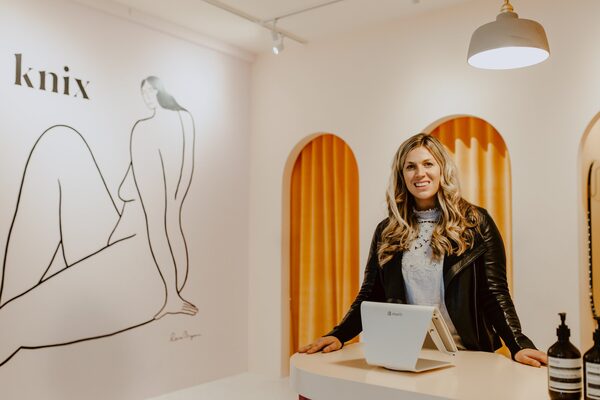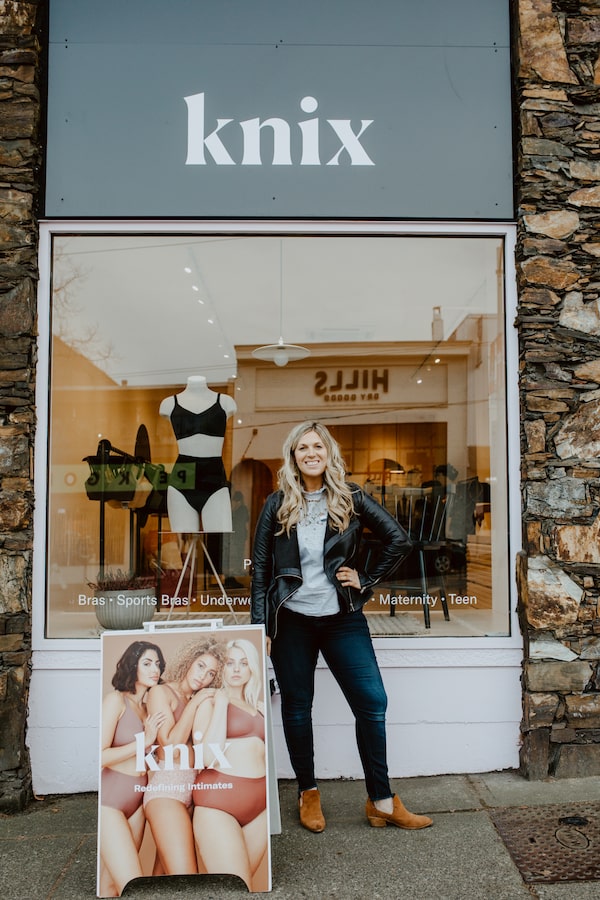
Joanna Griffiths is CEO of Canadian underwear brand Knix.Hayley Ng/Handout
Valentine’s Day is a time of performative romance, with all the attendant chocolate, flowers, and candlelight. But for those making an offering to their sweethearts, a product that once went under the working title “sexy diapers” is likely not at the top of the gift list.
That nickname was once what Knix’s first product – absorbent underwear that shields against light menstrual and urinary leaks – was called. While its product line has expanded, February has not typically been the strongest sales month for the Canadian underwear company.
“Even our diehard customers, it’s probably when they’re buying underwear from somebody else,” CEO Joanna Griffiths says. But after ending 2019 with the strongest sales in its six-year history, Griffiths envisions a day when Knix might become a contender on Valentine’s Day too.
Since its first crowdfunding campaign in 2013, Knix has attempted to redefine the underwear category by explicitly acknowledging the bodily experiences women have historically been told not to discuss. While it’s not the first lingerie company to advocate for authenticity – or the only one led by a female CEO, a fact it often promotes – Knix has successfully positioned itself as a brand that celebrates an inclusive image of femininity. And it’s built strong relationships with women by focusing on e-commerce and direct-to-consumer communications.
The Toronto-based company has trumpeted comfort, minimalist designs and sizes ranging from small to XXXL (equivalent to pant sizes 2 to 26) and bras from 32A to 42G. And it has pushed back against size-zero Victoria’s Secret-style marketing, by featuring its own customers (alongside models of all sizes) in campaigns. It shows bodies with stretch marks, mastectomy scars, and thighs and bellies that curve outside the linear forms of a conventional catwalk. “The whole concept of what’s sexy is completely evolving,” Griffiths says. “What’s aspirational now, is being comfortable with who you are.”
Other innovative lingerie companies are doing the same. Pop star Rihanna launched her lingerie line Savage x Fenty in 2018. At its inaugural show during New York fashion week, in addition to models such as Bella and Gigi Hadid, her brand sent pregnant and plus-sized women down the catwalk. Diversity is also used as a marketing tool by Aerie, the underwear brand owned by American Eagle Outfitters, and San Francisco-based ThirdLove.
Wendy Evans, retail expert and president of Evans & Co. Consultants, says that the messages Knix puts out resonate strongly with its audience. “There are a lot of women who have identified with the beautiful but imperfect bodies that [Griffiths] shows,” she says. “There are 800 million women who have periods. … She’s putting it out there.”
The company’s employee count has more than doubled in the past year to 80 people, in November, it raised $5.7-million in venture capital financing and last year sales reached approximately $50-million. It also opened its first two retail stores, in Vancouver and Toronto and plans to expand with three more this year; two in Canada and one in the United States. Today, Knix’s product line includes a collection for teens; a high-impact sports bra; swimwear; underwear with abdominal support for postpartum bodies; and shorts designed to battle the scourge of thigh-chafing. It is currently working on designing a strapless bra.

The company opened its first two retail stores – in Vancouver and Toronto – this year.Hayley Ng
To date, much of the brand’s development has been singularly driven by Griffiths’s own experiences. “Knix as a brand is an extension of me for sure,” she says. “I’ve been every size. My weight has fluctuated a lot, like a lot of women.”
Before Griffiths became pregnant with her son, the company was developing a nursing bra – but her own experiences began to inform product development. At eight months, she stood in her office as her team drew bands around her abdomen as part of the design for the high-rise CoreLove underwear, which are built to provide extra support. Immediately postpartum, she presented her team with the idea for the Life After Birth campaign, which solicited photos from real women giving an intimate glimpse into the experiences with their changing bodies. The campaign began with a photo exhibit in New York and continued on social media, with participation from celebrities such as Amy Schumer and Jemima Kirke.
“She understands her brand – it’s authentic. This is what she’s about, and it happens to coincide with a pretty big trend among consumers. Consumers want brands to be real,” says John Bahr, managing partner and founder of private equity firm AHR Growth Partners, which was an early investor in Knix.
But not everything has gone smoothly. Companies that trumpet women’s empowerment come under scrutiny from skeptical consumers who wonder how genuine those messages are. Last year, ThirdLove faced reports of low pay and a “toxic” workplace culture. The founder of Thinx, another brand that makes leak-proof underwear, left in 2017 following allegations of sexual harassment. And this January, Thinx denied a report that some of its panties contain per- and polyfluoroalkyl substances (PFAS), endocrine-disrupting chemicals that are used to make products water- and stain-resistant. (The impacts of PFAS exposure still aren’t certain, but they’ve been linked to issues such as higher rates of some cancers, fertility complications and suppressed immune systems.) That news prompted Knix to release a statement saying it had done additional testing on its own menstrual underwear to confirm it “free of harmful chemicals and PFAS.”
And last September, Knix faced criticism after the company released an ad on Facebook that the company said was produced during a brainstorming session and never meant to be distributed. It showed a crumpled pair of underwear on the ground next to a discarded pair of high heels, with the words, "What happens in Knix Leakproof stays in Knix Leakproof." After complaints about the ad – including a suggestion that it evoked associations with sexual assault – the company apologized. At the same time, however, Griffiths blamed media for making “a story out of nothing” in an Instagram Stories post that referred to journalists following the story as “vultures.” It was an abrupt reaction from the founder, who has welcomed positive media coverage in the course of building her brand, only to lash out at media asking tough questions.
“Brands like Knix are used to controlling the narrative,” says Cora Harrington, the New York-based founder of the Lingerie Addict blog, which has covered the lingerie industry since 2008, adding that many of these brands have used media outreach as a way to build an audience of potential customers. “If the PR machine is working for them, then it’s wonderful and great and they deserve it. But if there’s an issue, people are picking on them. These brands aren’t used to criticism.”
Griffiths’s feelings on the subject have not changed – she maintains that a few angry tweets deserved an apology, but should not have made news. But female consumers force-fed a steady diet of sales pitches cloaked in faux-empowerment are understandably skeptical. And keeping those customers’ loyalty will depend on listening to them, including when the feedback is negative.
The company, for instance, is hearing from current and prospective customers who think there’s room for improvement with its product offerings. Its minimal designs don’t work for everyone – customers have been requesting prettier fare – so in March, Knix is bringing back styles that include lace. And despite its range of sizes, there are still segments of the market – people with small cup sizes and larger rib cages, as well as the inverse – who can’t find their size at Knix. The company is looking at addressing both of those concerns.
“People are really telling you what they want to see and what they don’t want to see,” Griffiths says. As Knix looks to continue building on its rapid rise, listening to consumers, whether online or in store, will prove vital.
Visit tgam.ca/newsletters to sign up for the weekly Style newsletter, your guide to fashion, design, entertaining, shopping and living well. And follow us on Instagram @globestyle.
 Susan Krashinsky Robertson
Susan Krashinsky Robertson